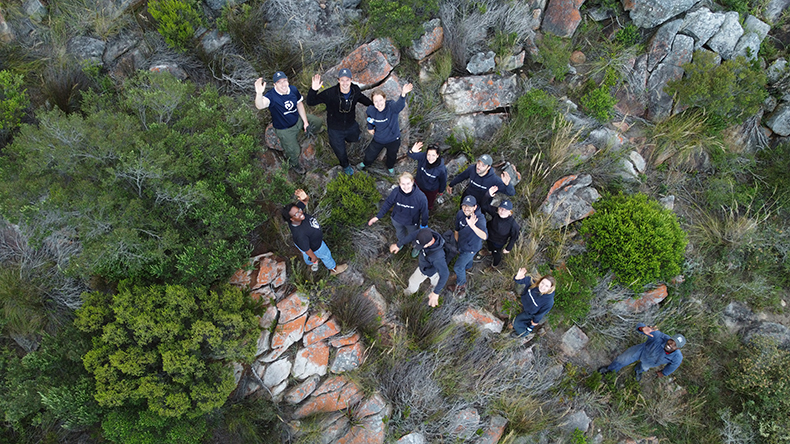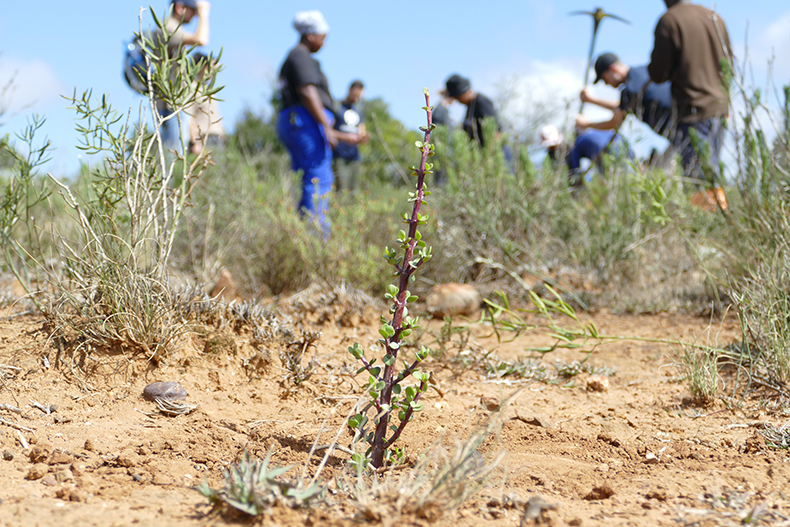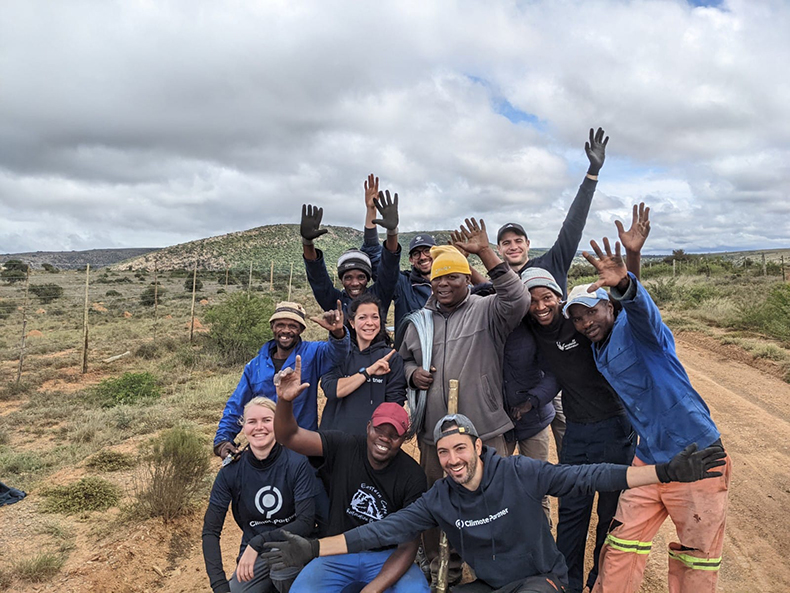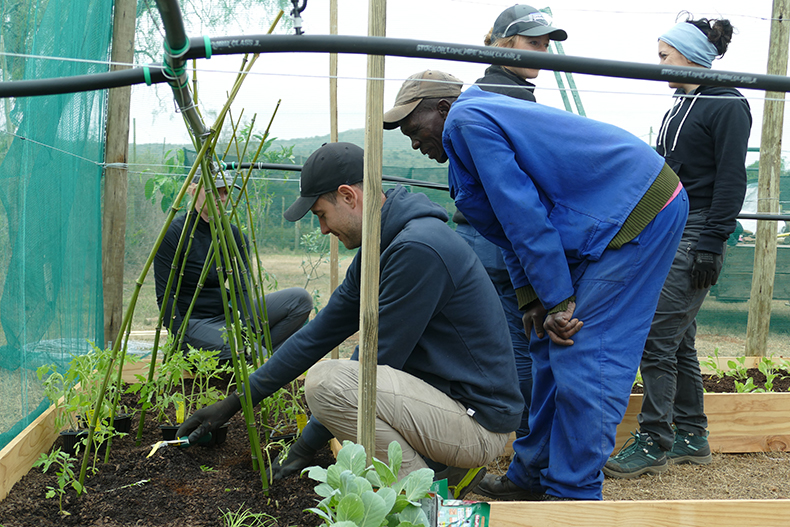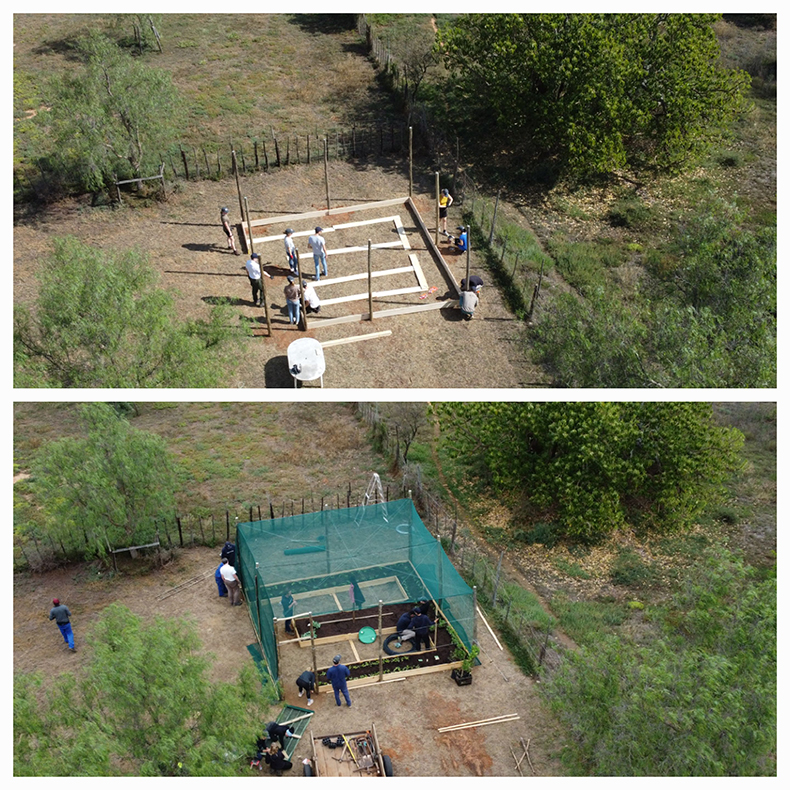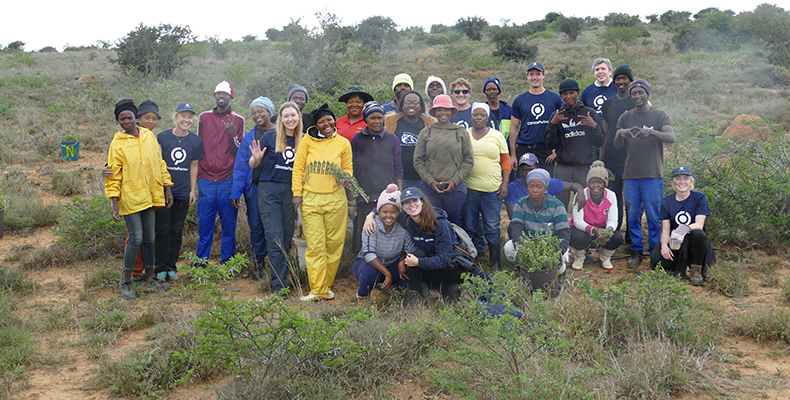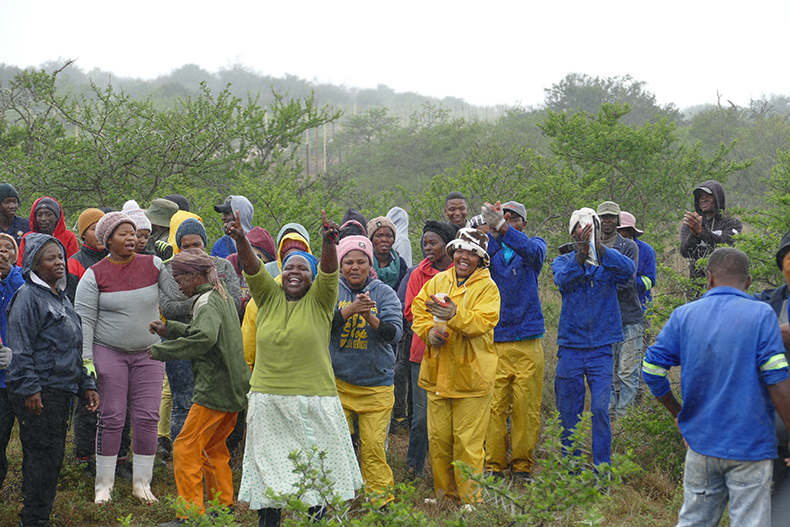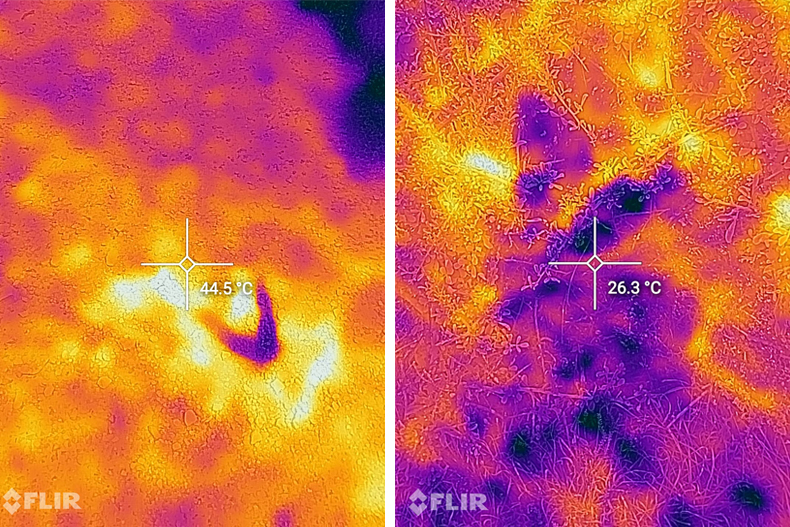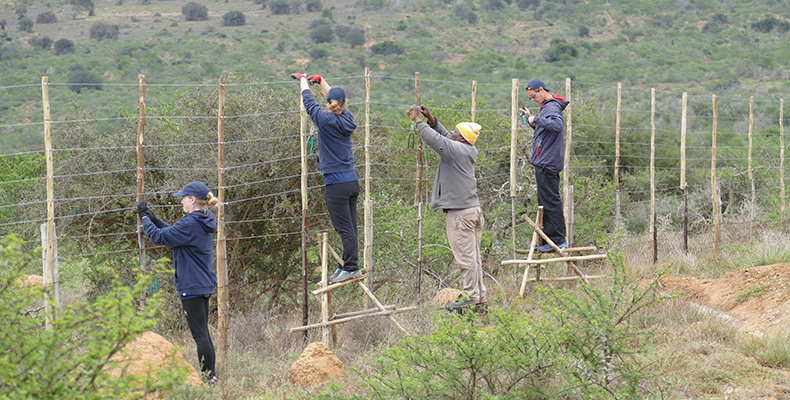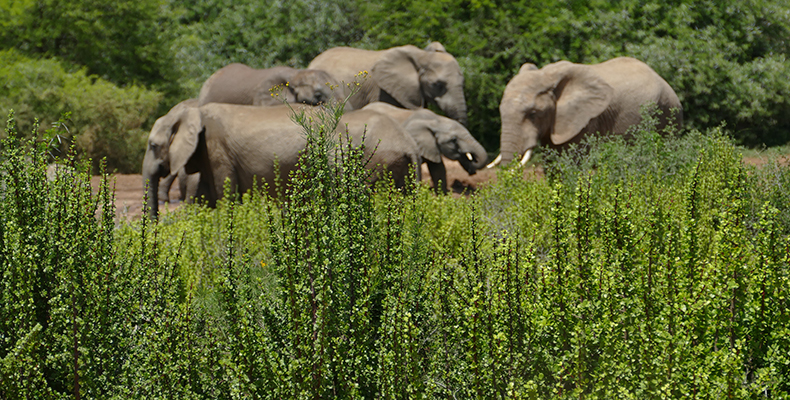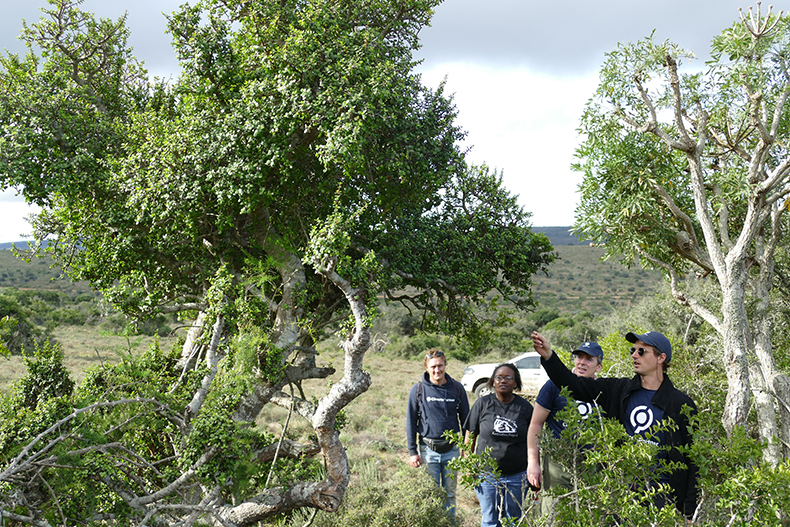People, Nature, and Carbon: our project visit in South Africa

What an incredible 10-days in South Africa developing one of our Nature-based Solution carbon removal projects. It is hard to summarise the whole experience in words, as there was such a wealth of constructive knowledge sharing, friendships and collaboration that took place in a beautiful region with extraordinary local people.
Our aim was to reforest degraded Sub-Tropical Thicket with the reintroduction of a succulent shrub called Spekboom (also known as the Elephant Bush) which is indigenous to the Eastern Cape of South Africa. What unfolded for me and the in-depth knowledge that the whole project team gained, was far beyond anyone’s expectations. Our time on the ground helped us truly understand how a thicket biome reforestation project can deliver socio-economic impact, influence the future evolutionary direction of that ecosystem, and restore the soil health. The visit was truly insightful and left a profound impact on us all.
Personally, for me, the experience has reinvigorated?my passion for practical on the ground solutions, especially those outside of corporate value chains. It has been incredible to dive into the complexities of the project and its associated risk management strategies to understand how it can deliver tangible and meaningful impacts. It is inspiring to learn how these impacts go beyond carbon removal and will provide water security, biodiversity gain, soil restoration and employment opportunities for the local communities. Below I cover three main aspects, including our experience working in the field, the amazing interactions we had with the local community and finally the key learnings that I have discovered around the need for collaboration to regenerate our soils and nature.
Life working in the field
Instantly we were thrown in at the deep end and it quickly became clear that this was going to be a lot of hard work, requiring grit and determination to get a successful job done. To gather the insight and gain a true understanding of the project, we got our hands dirty from the get-go, building, digging, planting, and fencing alongside the workers in the field. With many blistered hands and lots of sunburn by the first lunch break, we all quickly gained a huge amount of appreciation and respect for the complex socio-economic and ecological considerations required to make the project successful.
We all had to quickly adapt to life in the field, embrace the experience and get stuck in. Up early every morning, typically without power as the grid would go down for hours at a time, we would have breakfast at 7am and then be out in the field on the back of a pickup truck by 8am. We all had a sharp wake up call to the intense physical work required (quite a contrast to our current desk jobs!) especially as we got further into the week and the initial anticipation and excitement wore off and was replaced with aches and pains.
At first the work was a little slow. It took a bit of getting into, not only because we didn’t know how to build the 2m high fences or the best ways to plant spekboom, but also as the local workers were shy at first and it took a day or so for us to form relationships and build trust. We then quickly learnt their techniques, from using the pliers properly for fencing, to best practice for swinging a pickaxe all day, and planting the Spekboom to give it the best chance of survival.
By the second day of the project visit we started to really get into the swing of things, and it was hugely rewarding, not only due to the work we delivered but also the impression we left on our project partner EcoPlanet and the local workers in the field. I was personally so proud of the whole ClimatePartner team, many of us who had never met before, being based in different European offices across different departments. We all clicked into a very special and closeknit team, with a fantastic attitude towards every task. It was a privilege to work alongside my international colleagues, who all gave 110% right up until the final day, which has resulted in some incredible friendships and a deep appreciation and respect for one another. By the end of our fieldwork, we were proud to have put up around 2 kilometers of fencing and planted just short of 1,000 new Spekboom plants, along with a range of other community projects.
Other tasks we completed included planting cuttings to form roots in the nursery and planting two irrigated rows of Spekboom that will be the mother plants for future cuttings. These are important to mitigate project risk, as they can be used to replant in areas where the saplings have not survived or have been destroyed by wildlife.
One of the most rewarding projects we completed was building a community vegetable grow house for the local workers, alongside planting a range of fruit trees. Creating the grow house from scratch gave everyone a great sense of achievement and it turned out to be a fantastic piece of carpentry! We also expanded a chicken coop to provide eggs to the workers.
Additional community projects like the grow house and chicken coop are important in contributing to the social impact of the project. The workers’ families living in local towns across the Eastern Cape of South Africa tend to have poor nutrition. By giving the workers access to fresh produce and a sustainable way to grow healthy foods, the most vulnerable members of the workforce can be supported in times of need.
The people and community
Opportunity in the Eastern Cape historically came through agriculture. However, this sector is currently failing because these landscapes have been degraded to the point where the soils are no longer fertile, and the water tables are no longer stable. This makes projects like this particularly important in the region, looking at impact beyond carbon sequestration and soil regeneration to provide economic opportunity for the local community.
As we spent more time in the field with the local workers and EcoPlanet, it led to some amazing relationships being developed. We showed them that we were hard working, which in turn bought us a lot of respect and led to some meaningful and important conversations taking place. I developed a good friendship with Mozolisi a field worker who taught me the best way to swing a pickaxe! After many hours of hard work, we had talked about football and other trivial subjects, and then he wanted to get a better understanding of why I was there. ‘Yes, but why?’ At first, he could not understand. ‘Why would you want to come all the way from London to be in the field in the middle of the Eastern cape, miles from anywhere to work with me?’
When I explained further that ClimatePartner were providing the finance for EcoPlanet to complete the work, he displayed a great deal of gratitude and respect for the support we were providing to him, his family, and his community. The field workers had been informed about the purpose of our visit and the wider project goals, which created a shared sense of joy. We sang songs together, and they had a great appreciation for us being there. The following days were filled with song and laughter. A particular favourite of mine was ‘Shosholoza’:
Shosholoza (Moving Fast And Strong)
Kulezontaba (Through those Mountains)
Stimela siphum’e South Africa (On A Train From South Africa)
As I got to know Mozolisi and the other workers better and they got over their camera shyness, we took a few selfies and had great fun, which made the tough field work more bearable. As our conversations developed, it made me more inquisitive into their lives and how they lived. Mozolisi went on to explain that he had never had a stable job in his life, always picking up some manual labour work here and there where he could. He told me how he would stand on the side of the road in town with a sign saying he was available for work and would get picked up for few hours at a time, all cash in hand, to try and put food on the table for his wife and two girls. His eldest daughter was now 13 years old and still studying at school and he explained how tough it was to never know when he would next have work and be able to provide for his family.
It was emotional to learn about the hardship that all the workers were facing in the Eastern Cape of South Africa. To see how badly the soils are degraded, the devastating impact intensive agriculture has had on the landscape and to hear from the locals about such scarce employment opportunities, was a real wake up call to the stark reality of life there. The more we started to form friendships, the more they started to open up about their life stories. Most had left school by their early teens, there was no culture around completing education, and many would get into trouble in various ways early on in life. One of the local towns has a 49% unemployment rate, and everyone I spoke with said they were unemployed and had nothing at all to do before the job working on the project.
A local called Stone, who had recently been promoted to Farm Manager, and Khuli who was the project manager, were full of passion and energy for the project and it was amazing to work alongside them. They explained to me that when they would announce they were hiring, word would spread around the area like wildfire and the next day they would have 200 people at the gates looking for work. It was brilliant to learn more about the selection process, which requires a 50:50 ratio men to women split, and they also ensure that the workforce come evenly from the two towns on each side of the farm to give equal opportunities. It doesn’t matter who you are, how old you are or what background you are from – if you can do the work, you get the job.
The workers all receive travel allowances so they can get to and from the farm, and are paid above minimum wage, with a bonus on top if they hit their fencing or planting daily targets. Most importantly, the workers receive help in opening bank accounts to ensure they are on the payroll with official pay slips. Few of the workers previously had bank accounts, and this means they now have access to government benefits, including the right to claim unemployment if they find themselves out of work and have a claim to the government backed pension in the future.
What I can say for sure is that the whole project team had a profoundly positive experience, and with a lot of hard work, collaboration, laughter, blood, sweat and tears we formed some incredible relationships and left the project inspired. The final day of our field work was very emotional. As we came down the gravel dirt track towards the area we had been working on, there was song and music in the air, getting louder and louder as we approached the gate. This was not rare, most days we would hear workers in their groups singing, laughing, and joyfully going about their work in the field, however as we came around the corner, everyone was gathered in one big group, singing, dancing, and clapping their hands. This was a truly emotional experience for everyone in the team, myself included.
The time we had spent together had been very special, the stories we had shared and the passion and gratitude all the locals had shown towards us really pulled at our heart strings. There was also the realization that as with all good things, it was coming to an end, and we would be leaving soon. We all started to join in with the singing and dancing, until an elder gentleman from the group stepped forward and hushed everyone so that he could say a few words. He spoke of the conflict South Africa had dealt with in the past, the brutality and war along with the hardships that they were all currently facing today. He went on to highlight the importance of the work that we were providing, not only for the 85 workers there, but for the whole surrounding community that was benefiting because of it. The message from the elder was from the heart and very clear. The gratitude with which he spoke to and the direct acknowledgment that they need our ongoing support, really demonstrated the importance of this project and I had to hold back the tears.
After his speech everyone started singing the South African National Anthem, which was very fitting as I was to later learn that the national anthem really represents the coming together of diversity in South Africa, the coming together of so many different groups, languages, and cultures. It was a beautiful representation following the elder’s speech; it was an honour to be part of that after such an incredible trip.
It felt appropriate to say a few words on behalf of ClimatePartner in response, although I had absolutely nothing prepared. I thanked them all for having us in their magnificent country, thanked them for being such inspiring people, and then outlined the importance of the work we were all doing here – beyond the pay checks it provides them with today, and how it will help to restore the natural habitat, provide the ecosystems for wildlife, and give a helping hand to this land to make it thrive again. It was so warming and surprising to see all the local workers agreeing and nodding along to my comments. My interpretation was that the majority of them were here for the money, and I am sure most are, however, to have such a collective appreciation for the impact that the Spekboom planting will have to help restore the land was amazing. Despite many locals not having an in depth understanding of the biology and ecology of the thicket biome it was so refreshing to see that they could relate to the bigger impacts of the project.
Key learnings – Soil, Nature & Collaboration
By the end of the trip one thing was very clear. It takes so many different parties at such different levels to make a project like this work. Nature-based Solutions are incredibly complex, and it takes everything from a company like ClimatePartner to provide the pre-financing, to having the right coordinator on the ground like EcoPlanet to implement the work, whilst also having buy-in from the local community with the right workforce. Continuous communication between all these parties is required, otherwise the project will be at risk.
The true star of the project is the Spekboom. It is a pioneer species, and an ecological engineer of the land. Found in a variety of thicket biomes across South Africa, it does an incredible job of restoring of the soil through its leaf litter, which results in microbial restoration. Spekboom creates favorable microclimatic conditions for other thicket shrubbery to flourish. Not only is it a delicious plant and a favorite of elephants and a range of other herbivores, but it is also hardy and resilient to the sometimes-brutal environment of expansive thicket planes. Once established, it can bind soil and increase water retention, which can ultimately support a multitude of other organisms in the thicket biome.
The two photos below that were taken on the project site via an Infrared Thermal Imaging camera, show that even small shrubs can provide shading from direct sunlight. This can reduce the surface soil temperature by nearly 50% (44.5 degrees vs. 26.3 degrees). These lower soil temperatures that can be achieved through the reintroduction of Spekboom, provide a more stable environment for less hardy species to start to reestablish themselves in the degraded habitat.
It is vital to look at the bigger picture and start to integrate long term visions for the landscape in the short-term objectives of the project. The fence building is an interesting aspect of this as we see a shift in human wildlife conflict, away from hunting of carnivorous predators to defend livestock to suddenly the biggest conflicting species becoming natural herbivories. The Kudu, Warthog, Duiker and Rheebucks now become the conflict species to ecological restoration and are the main cause of small Spekboom sapling mortality. It is now the herbivores who pose a threat to the newly planted saplings and recovering ecosystems.
The bigger picture is that the fences won’t have to be there forever and it’s a short-term strategy to restore the habitat until it has the capacity to hold natural livestock again. Wildlife plays a key role in a healthy thicket biome, trimming and propagating the trees and providing fertiliser to the soil. In the future they will play a key part in regenerating the landscape. A potential and aspirational long-term goal is to reintroduce not only the herbivores. If the scale of the project allows, there is a plan to reintroduce predators in a managed way that creates a natural closed loop system once again.
We are trying to restore ecosystems and put back what has been taken away by livestock over 200 years of intensive agricultural practice. It’s going to be an interesting paradigm shift to move away from managing land for livestock with a top-down focus, to a bottom-up systematic approach. Initially there will be conflicting ideologies as we need to reduce the numbers of wildlife to establish primary thicket biomes again, and fencing is a fantastic ethical management system to achieve that. The long-term goal of this project would look towards dropping the fencing and creating wildlife corridors as ecosystem restoration only happens at scales large enough to hold healthy sized populations of fauna. If you want to have positive wildlife outcomes, whilst they are initially a threat to the small saplings, natural herbivores are an incredibly important part of the carbon cycle, not only storing but also putting carbon back into the soil. This project has the potential, with the right pre-financing, to be expanded to a much larger area. There could be a future vision to create conservancies between landowners and smallholder farmers. By educating the next generation of local landowners on the future possibilities available, such as eco-tourism, we can drive for larger landowner collaboration and start to revalue the natural habitat, wildlife, and ecosystem services.
Once we start understanding how valuable the ecosystem is in terms of the services that it delivers to us, right from the basics of providing freshwater or having good topsoil for growing vegetables, the true co-benefits of carbon financing can start to be realised. It comes down to a drastic need to change our value systems to accommodate and acknowledge the true value of nature. It is no easy task, and I don’t have a definitive answer as to how this can be achieved, however we need to revalue and reassess how we can financially put a cost on all these different aspects that we are talking about.
As I mentioned at the start, this project visit has reignited a true passion for the opportunities we have to invest beyond corporate value chains. Taking this project as an example, if the long-term objectives are successful and we overcome the complex socio-economic and ecological challenges, we will be able to achieve a direct correlation to biodiversity net-gain, wildlife conservation, water security, soil regeneration, gender equality, and increased economic prosperity across the local community.
by Nicholas Daniel – Head of Commercial – ClimatePartner UK
N.B. The information contained in this entry is provided by the above supplier, and does not necessarily reflect the views and opinions of the publisher
